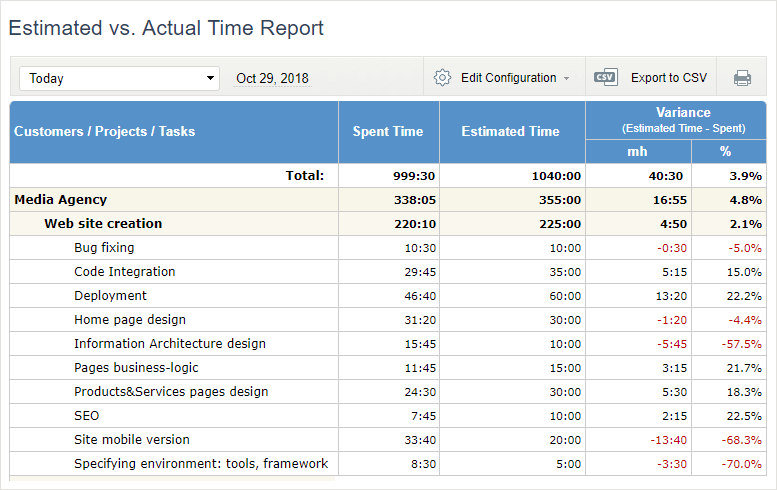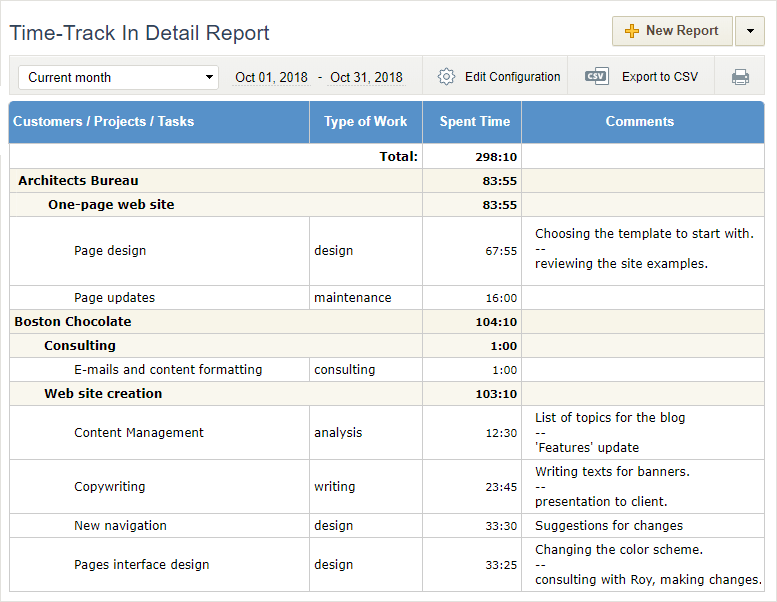
Monitoring current progress of project works is an essential task in terms of following project plan. Knowing current progress allows managers to identify necessary changes, resist possible scope bloat, and evaluate likely outcomes at the upcoming stages.
For different projects, different metrics are key for evaluating how current project status complies with the planned progress level. Mostly, hard numeric values are tracked and assessed: budgets, schedules, time estimates, worked hours, etc. However, qualitative indicators, such as customer satisfaction or employees’ loyalty, matter too. So, what are the techniques and practices for tracking project progress?

Project Status Monitoring Methods
Time Monitoring
This method basically consists of comparing current project status with planned timelines. The question it answers is: how exactly are we following the project plan? Depending on the detail level, the method can include monitoring of large milestones, teams’ and individuals’ schedules, and task deadlines.
As simple as it sounds, there are several technical recommendations on how to implement it. Here are the basic options on how to approach monitoring of schedules and time metrics:
-
Use PERT for progress monitoring.
Use timelines (optimistic, pessimistic, most likely, and expected time) to check actual results against them, see how changes affect the critical path, and use the obtained data in future planning.
-
Keep track of task statuses with Gantt charts.
Compare current statuses of your project’s milestones with planned deadlines. Use this visualization method to identify actual and possible schedule overruns, and take action as soon as possible.
-
Implement preset limits for tasks that are not time-critical.
Such limits will keep you motivated to work. Also, think about possible tolerances for deadlines in your project, and monitor schedules and deadlines against them.
-
Use time estimates and monitor how your team meets them.
Compare estimated vs. actual time (for example, by running a special report in actiTIME), that calculates the variance on a regular basis.

Budget Monitoring
Project budget monitoring is essential for ensuring profitability of the project. An important part of budget monitoring in the middle of the project is staying aware of project costs. Keep track of current costs of employees’ work, and analyze their structure. Use the obtained data for calculation of various indicators of project success:
-
Keep track of project profitability as a ratio between costs and billable amounts.
Consider setting up a report that automatically calculates this proportion, and run it on major project steps to see the dynamics.
-
Monitor the balance between planned and actual costs.
If actual costs exceed the planned ones, try to figure out what are the reasons of cost increase, and how it affects profitability.
-
Calculate earned value.
This will let you see how much value project costs bring. Also, use earned value data to identify whether budget adjustments are necessary.
-
Analyze the structure of project costs.
It’s not uncommon that works not billable to clients consume a large part of employees’ work time, undermining project profitability. See how non-billable works affect the resulting value of the project, and consider using it as an opportunity to cut project costs.

Regular Check-ins
As opposed to the previous monitoring methods, this method does not take into account any quantitative values. Instead, it is focused on qualitative side of project management and involves manual processing of more diverse data. However, it is an indispensable step of project status monitoring, as it helps managers and their teams stay updated on current progress and likely perspectives. Here’s what a manager can do to get valuable data first-hand:
-
Develop regular check-in procedures.
It can be regular project status meetings, reports that team leads need to prepare and submit, questionnaires, or any other form of feedback. The key point is collecting actual data on possible issues and difficulties, and being able to take action as soon as possible.
-
Listen to team members’ feedback, and encourage them to communicate more.
Explain how timely reporting of possible issues is important for successful delivery of a project.
-
Try formalizing your reports or questionnaires to simplify collected data processing.
This part of monitoring is hard to automate, but developing informative and consistent survey or report forms makes data analysis easier and allows you to reveal important trends and risks.
Monitor Project Status with actiTIME
Mostly, project status monitoring techniques are focused on quantitative values, as they are easier to process and provide more deterministic results. However, it is important to take into account qualitative parameters too. Besides monitoring schedule overruns, calculating estimate variances and running budget reports, collect employees’ feedback, encourage active communication within the team, and develop procedures for regular work progress check-ins.

















































